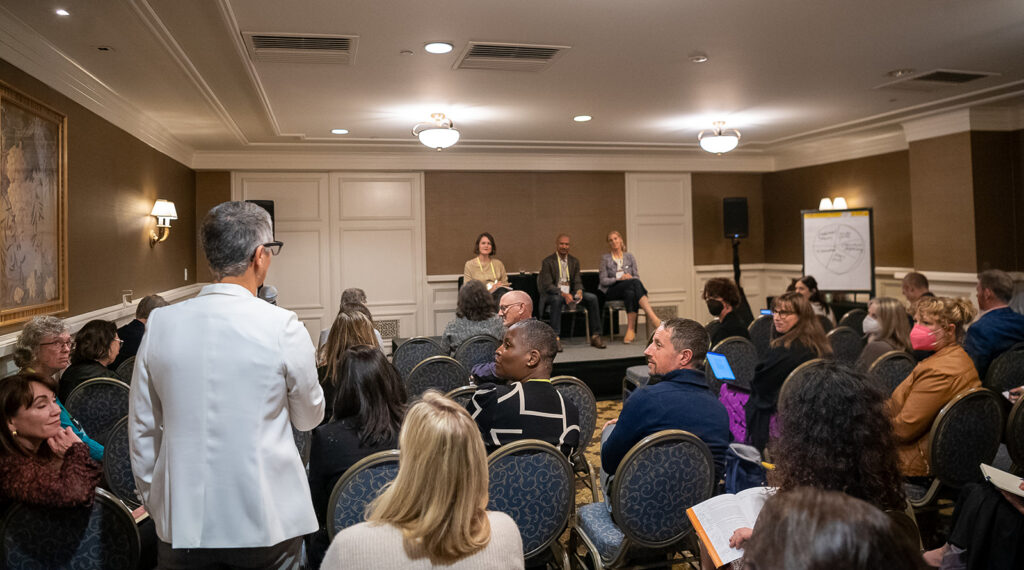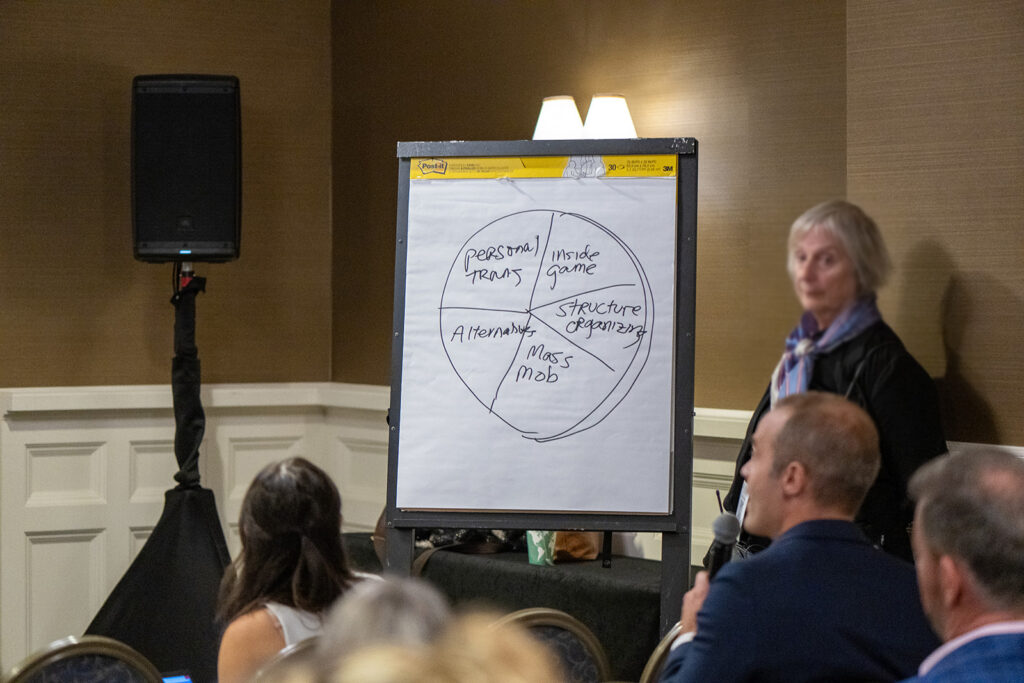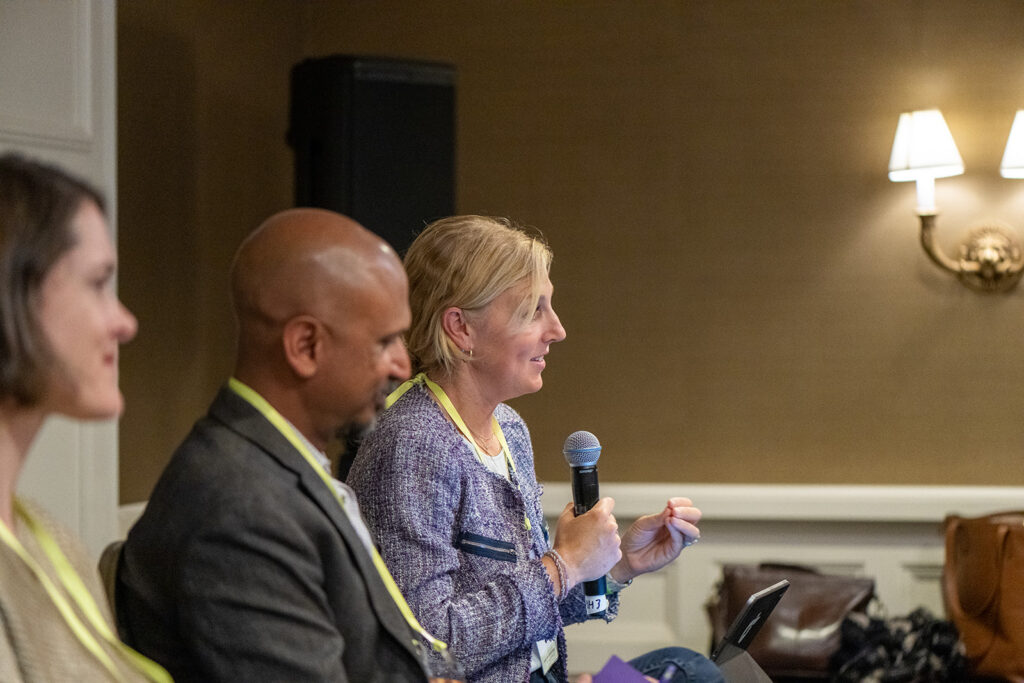Supporting Systems Change

An attendee at the 2022 National Forum on Family Philanthropy asks a question on systems change of speakers Chloe Cockburn, Piyush Tantia, and Kimberly Dasher Tripp
NCFP Senior Program Consultant Tony Macklin attended NCFP’s 2022 National Forum on Family Philanthropy. Read on for Tony’s takeaways from Funding Movements for Systems Change: There is a role for every type of funder.
“We want to get to the root of the problem, not just fund the symptoms.”
“We should go upstream and prevent these things from happening.”
I often hear these kinds of sentiments from donors and foundation leaders. Someone else usually responds, “But that seems complicated and risky, and we don’t have much money.”
They’re discussing their role in systems change—altering how policies, practices, resources, relationships, and mindsets hold a problem in place. At a 2022 National Forum on Family Philanthropy session, speakers Chloe Cockburn, Piyush Tantia, and Kimberly Dasher Tripp made systems change easier to navigate. I took away three important lessons.
Stay aware of the impact of systems
It’s easy to underestimate how much systems affect a person’s decisions and behaviors because the components of the system are often hard to see. For example, governmental regulations can influence the quality of the community in which a person was raised. The regulations might make it difficult to develop housing affordable for teachers and public safety workers or allow toxic dumps to be located nearby. Or, ever-changing school and university funding formulas can alter the quality of education an individual and their children can obtain.
Piyush Tantia, chief innovation officer at the nonprofit ideas42, said, “Systems are made of interconnected agents—people, organizations, policies, social norms, infrastructure, data, and more. You’re part of the system if you’re trying to change it.”
None of us can escape the impact of the systems around us. And, no matter your philanthropic goals or the size of resources you’re committing, you have a role to play in systems change.
 Pick a leverage point
Pick a leverage point
Because systems contain many components, you don’t have to try to tackle the entire system at once. Instead, you can find a leverage point that aligns with your philanthropic goals and resources.
Chloe Cockburn, Founder and CEO of Just Impact, has specialized in finding those leverage points. Inspired by the nonprofit Ayni Institute’s work on movement ecology, she described five leverage points in a system:
- Personal transformation—what we can change within ourselves or others to think and act differently. For example, we could have dinners with ex-offenders and their families to understand problems in the legal and prison systems. And, we could fund mentorship, leadership development, mental health, and healing programs for those ex-offenders and their families.
- Alternatives—new visions of a better world and new approaches to achieve those visions. We can donate to pilot programs that challenge the status quo. Or we can model new practices, such as sharing decision-making authority over grants with people most affected by a problem.
- The inside game—the formal leaders, rule makers, and power brokers in the system. We could use our connections to influence a mayor, school board, or CEO of a local bank. Or we could work with lobbyists, litigators, and administrators who know how to change policies and practices behind the scenes.
- Structure organizing—people collectively making demands of decision-makers through organizations such as unions, neighborhood associations, and interfaith coalitions. We can donate money and free meeting space, stand beside them publicly, and introduce them to others who share their beliefs.
- Mass mobilization—movements and media work that reshape what the public thinks about what’s right and wrong in a system. Some movements are more loosely organized, while others are incorporated and well-staffed. We can fund strategic communications and public opinion research or donate to the operations of movements. We can also volunteer and amplify those movements’ messages.
Chloe noted that people and organizations working in one of these leverage points need successful partners in all the other points. Systems change is more successful when all five leverage points are well-resourced.

Kimberly Dasher Tripp speaks about systems change in family philanthropy at the 2022 National Forum on Family Philanthropy
As a donor or funder, you can pick one leverage point as a funding priority and learn to be an effective partner in it. But it would be best if you also understood who the funders and strategists are in the others. Philanthropic advisor and NCFP board member Kimberly Dasher Tripp suggested asking other funders, donor collaboratives, and issue funds how philanthropic resources are being used in each leverage point. (Hint: Giving Compass and Stanford PACS have lists of issue funds, intermediaries, and donor collaboratives).
Be patient and persistent
Once you’ve decided to work on systems change and chosen a leverage point, commit to being a patient and persistent funder. Systems change is a long game and organizations will always encounter unexpected setbacks and opportunities. There will be months, years, election cycles, or economic cycles that make conditions more or less ripe for change. To be a successful funder of systems change work, the session speakers and audience members suggested:
- Providing multi-year operating support to a few critical partners so they can weather low points and jump quickly on opportunities.
- Supporting scenario planning exercises so groups of grantees and other stakeholders can prepare for new situations.
- Funding narrative change—altering the themes and ideas that stick in our heads about how things work.
- Thinking beyond nonprofits and getting to know grassroots, business, and political leaders who have a stake in changing or preserving the status quo.
Ultimately, funding systems change is about rededicating ourselves—and our philanthropic resources—to a larger purpose and longer time horizon. We find inspiration in a collective commitment to pursuing fairer results for others even when we can’t always see the immediate results. Systems change, at its best, is collaborative, patient, inclusive, and responsive to those who are most impacted by unjust systems. It requires listening to community, the ability to adapt to changing circumstances, and a willingness to focus on the collective outcomes—many of the same traits that families practice in their philanthropic work.
That combination of inspiration and impact are powerful ingredients for a legacy of effective family philanthropy. If you’re ready to explore such a legacy, I encourage you to dive into the resources below and contact NCFP’s team to meet other philanthropic families working on systems change.
Recommended Resources
- Families Funding Advocacy and Policy Change (NCFP Webinar)
- Funding Narrative Change, An Assessment and Framework (Convergence Partnership, 2022)
- Funding Social Movements (Ayni Institute)
- Move The Money: Practices and Values for Funding Social Movements (Building Movement Project, 2021)
- Philanthropists Must Invest in an Ecology of Change (Chloe Cockburn, 2018)
- Systems Change: Pursuing Transformational Philanthropy (NCFP Content Collection)
- Systems Grantmaking Resource Guide (Grantmakers for Effective Organizations and Management Assistance Group, 2016)
- The Water of Systems Change (FSG, 2018)
Tony Macklin is a Senior Program Consultant at the National Center for Family Philanthropy (NCFP)
